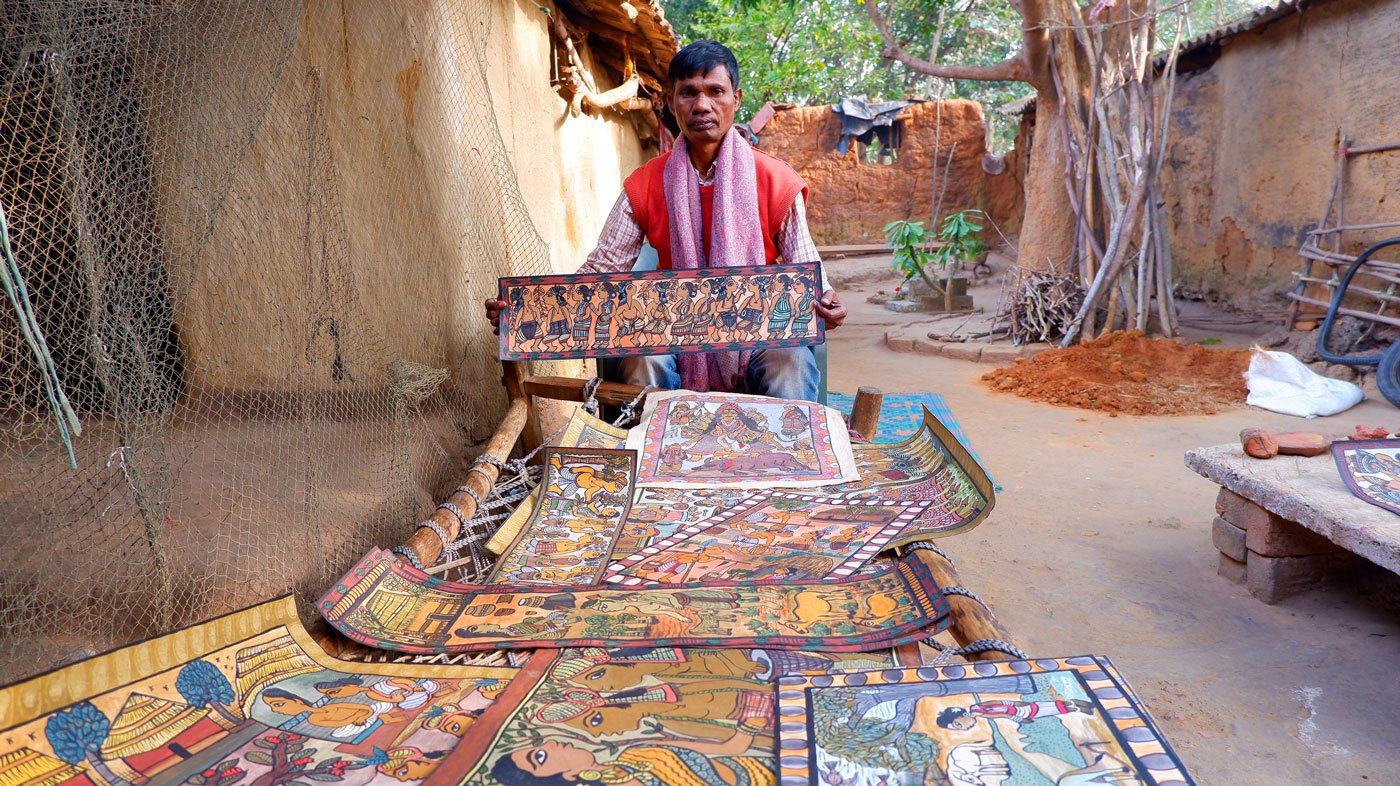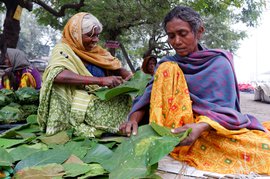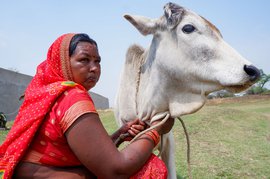Durga
Durga bole amar,
Dogdho holo kaya,
Ekbar de go maa,
Choroneri chhaya…
My body burns away,
'Durga Durga' I utter,
For the solace of your grace
I beg you O Mother...
Artist Vijay Chitrakar’s voice rises as he sings in praise of goddess Durga. Paitkar artists like him typically write the song first and then create the painting – going up to 14 feet in length – and presented to the viewer accompanied by storytelling and music.
Vijay, 41, lives in Amadobi village in Purbi Singhbhum district of Jharkhand. He says Paitkar paintings are based on local Santhali stories, rural lifestyles, nature and mythology. “Our main theme is rural culture; the things we see around us, we depict in our art,” says Vijay who has been making Paitkar paintings since he was 10 years old. “Karma dance, Baha dance, or a painting of the Ramayana, Mahabharata, a village scene...” He spells out the different parts to a Santhali painting, “it shows women doing household chores, men in the fields with bullocks, and birds in the sky.”
“I learned this art from my grandfather. He was
a very famous artist, and people used to come from Calcutta [Kolkata] back
then, to listen to him [sing his painting].” Many generations of Vijay’s family
have been Paitkar painters and he says, “
Pat
yukt aakar, mane Paitikar, isiliye Paitkar painting aya
[The shape was like
a scroll, hence the name Paitkar painting came from it].”


Left: Vijay Chitrakar working on a Paitkar painting outside his mud house in Purbi Singhbhum district's Amadobi village. Right: Paitkar artists like him write song and then paint based on them

Paitkar painting depicting the Karam Dance, a folk dance performed to worship Karam devta – god of fate
Paitkar art originated in West Bengal and Jharkhand. It blends storytelling with intricate visuals, and was influenced by ancient royal scrolls known as pandulipi (manuscript scrolls). “It is quite difficult to determine how old this art form is because it has been passed down from generation to generation, and there is no written evidence of it,” points out Professor Purushottam Sarma, Assistant Professor at Ranchi Central University, and a specialist in tribal folklore.
Amadobi has many Paitkar artists and at 71, Anil Chitrakar is the oldest painter in the village. “ In each of my paintings, there is a song. And we sing that song,” explains Anil. Showing PARI a scroll painting of Karma dance at a major Santhali festival he adds, “Once a story comes to mind, we paint it. The most important thing is to write the song, then make a painting, and finally sing it to people.”
Both Anil and Vijay are among the handful of painters who possess the musical knowledge needed to be a Paitkar artist. Anil says that the music has songs for every emotion – joy, sorrow, happiness, and excitement. “In the rural areas we sing songs based on festivals around gods and epics – Durga, Kali, Data Karna, Nouka Vilash, Manasa Mangal and more,” he says.
Anil learnt music from his father and is said to
have the largest repository of the songs associated with the paintings. “During
[Santhali and Hindu] festivals we used to travel from village to village
showing our paintings, and singing accompanied by the
ektara
[a single-stringed instrument] and harmonium. In return,
people bought paintings and gave some money or grains,” he adds.
Paitkar art blends storytelling with intricate visuals, and was influenced by ancient royal scrolls known as
pandulipi
(manuscript scrolls)
Paitkar paintings have in recent years shrunk form their original 12 to 14 feet length describing a folk tale around the origin of Santhals, to A4 size – a foot long, sold for Rs. 200 to Rs. 2,000. “ We cannot sell big paintings, so we make small paintings. If any customer comes to the village, we will sell them for 400-500 rupees,” says Anil.
Anil has also participated in several national and international fairs and workshops. He points out that the art is known internationally but it is not a sustainable livelihood. “The arrival of mobile phones has led to a decline in traditions of live music as there are so many mobile phones now that the tradition of singing and playing music has ended. What used to be an old tradition has disappeared. Now, what kind of song is there, fulka fulka chul, uddi uddi jaye ,” says Anil mimicking a popular song’s lyrics about wet hair flying in the breeze.
The veteran artist says there were once over 40 households in Amadobi who did Paitkar painting, but today only a few houses still practise the art. “ I taught painting to many students, but they all quit because they didn't earn money from it and now work as labourers,” says Anil. “ I also taught my sons this skill, but they left because they couldn't earn enough from it.” His eldest son works as a raj mistiri (mason) in Jamshedpur, while the younger one works as a labourer. Anil and his wife live in a small hut in the village and they keep a few goats and chickens; a parrot rests in a cage outside their home.
In 2013, the Jharkhand government made Amadobi
village a tourist centre but it has attracted only a few tourists.
“
If a tourist or
sahib
[government official] comes, we sing for them, and then they
give us some money. Last year, I sold only two paintings,” he says.


Anil Chitrakar, the oldest Paitkar artist in Amadobi village, with his paintings

Paitkar paintings illustrating the Bandna Parv festival and related activities of Adivasi communities of Jharkhand
Artists
also sell paintings in nearby villages during Santhal festivals like Karma
Pooja, Bandhan Parv, as well as local Hindu festivals and fairs. "First,
we used to go to villages to sell paintings. We used to go very far, even to
places like Bengal, Odisha, and Chhattisgarh,” said Anil Chitrakar.
*****
Vijay shows us the process behind Paitkar art. He first pours a little water onto a small stone slab and rubs another stone against it to extract a muddy red colour. Then, with the help of a small paintbrush, he starts painting.
The colours used in Paitkar paintings are sourced from riverbank stones and extracts of flowers and leaves. Finding stones is the most challenging task. “We have to go to the mountains or the riverbank; sometimes it takes three to four days to find limestone ,” says Vijay.
Artists use turmeric for yellow, beans or
chillies for green, and the fruit of
Lantana
camara
for violet. The black colour is prepared by collecting soot from
kerosene lamps; Red, white, and brick colours are extracted from stones.


Left: The colors used in Paitkar paintings are sourced naturally from riverbank stones and extracts of flowers and leaves. Right: Vijay Chitrakar painting outside his home

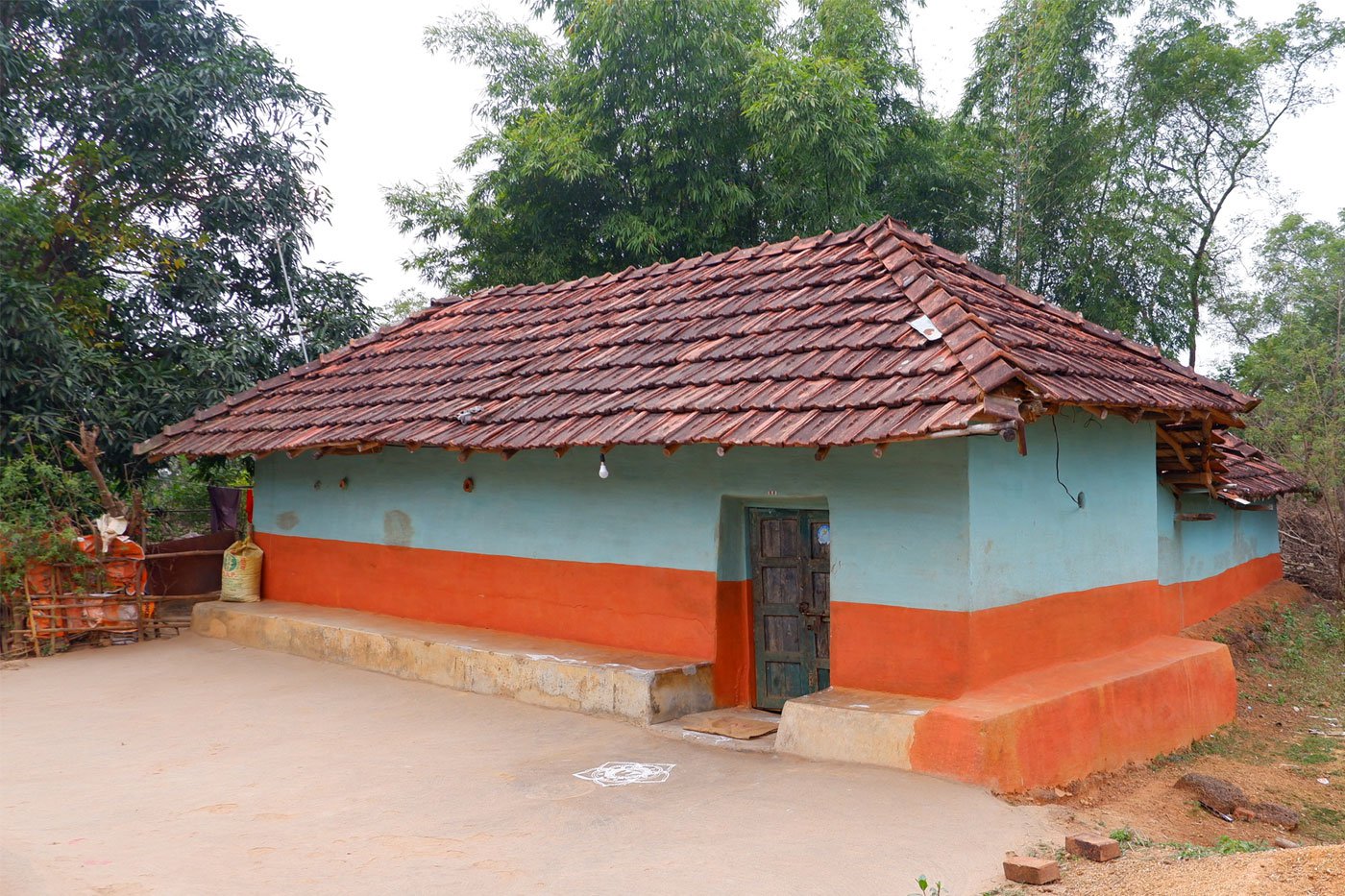
Left: Vijay Chitrakar making tea inside his home. Right: A traditional Santhali mud house in Amadobi village
Although paintings can be made on cloth or paper, today, most artists use paper which they buy from Jamshedpur, 70 kilometres away. “ A sheet costs between 70 to 120 rupees and we can easily make four small paintings [from that]," says Vijay.
These natural colours are mixed with resin of
the
neem
(
Azadirachta indica
) or
babool
(
Acacia nilotica
) trees to preserve
the paintings. “This way, insects won't attack the paper, and the painting will
remain as it is,” says Vijay who says their use of natural colours is a big
draw.
*****
Eight years ago, Anil developed cataracts in both eyes. As his vision blurred, he stopped painting “ I can't see properly. I can sketch, and narrate songs, but I can't fill colours,” he adds, holding up one of his paintings. These paintings bear two names – one is Anil’s for the outline, and the other name is that of his student who filled in the colours.


Skilled Paitkar painter, Anjana Patekar is one of the few women artisits in Amadobi but she has stopped painting now
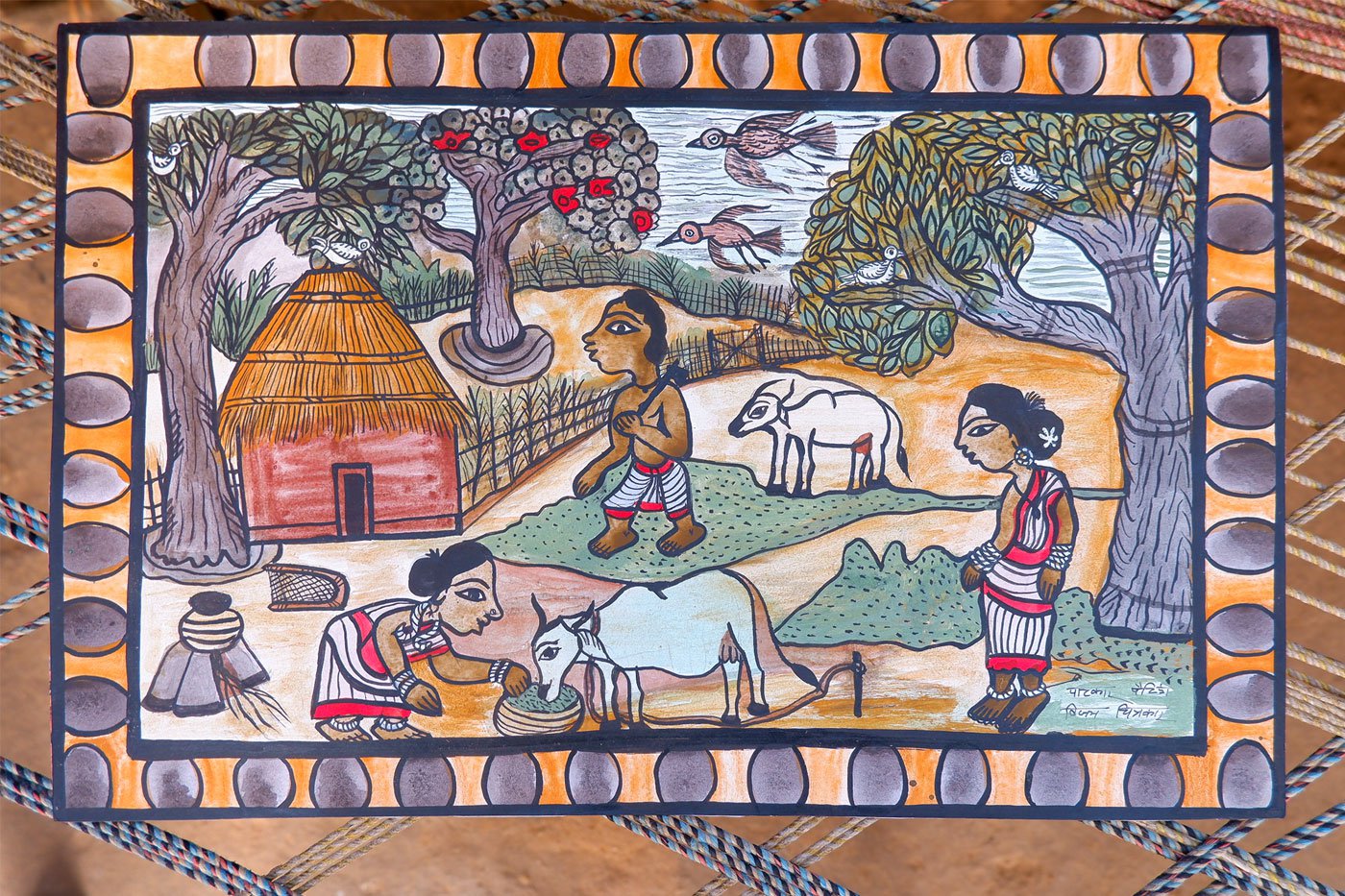
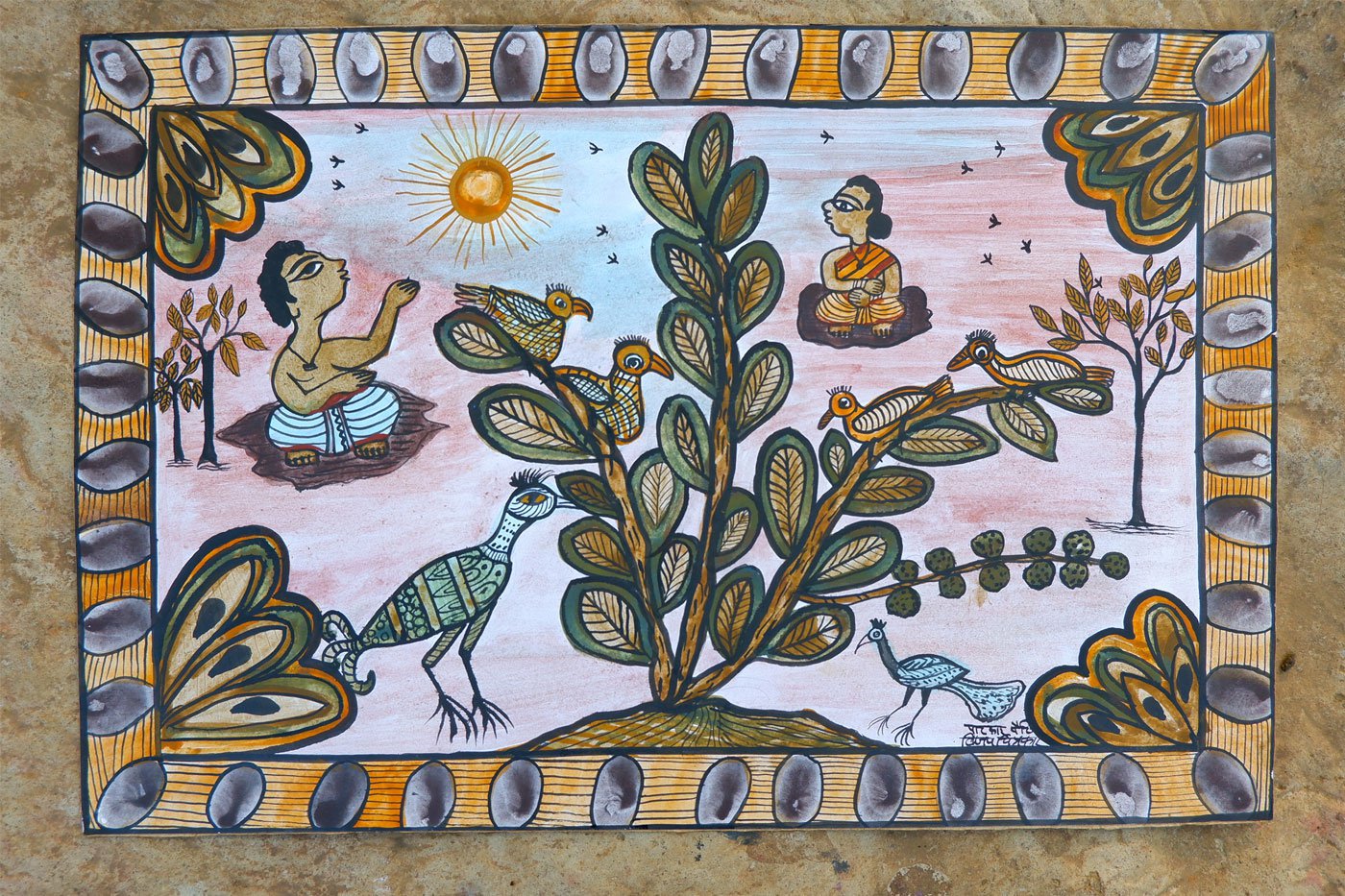
Paitkar paintings depicting Santhali lifestyle. 'Our main theme is rural culture; the things we see around us, we depict in our art,' says Vijay
Anjana Patekar, 36, is a skilled Paitkar artist but she says, “I have stopped doing this work now. My husband gets upset, wondering why I tire myself by painting alongside household chores. It's exhausting, and what's the point if there's no benefit? ” Anjana has 50 paintings but is unable to sell them. She says her children are not interested in learning this art form.
Like Anjana, 24-year-old Ganesh Gayan was once proficient in Paitkar painting but today he manages a grocery store in the village and occasionally takes up manual labour. He says, “I sold only three paintings last year. If we depend only on this income, how will we sustain our household?”
“ The new generation doesn't know how to write songs. Only if someone learns singing and storytelling will Paitkar painting survive. Otherwise, it will die,” says Anil.
The Paitkar songs in this story have been translated by Joshua Bodhinetra with help from Sitaram Baskey and Ronit Hembrom .
This story is supported by a fellowship from Mrinalini Mukherjee Foundation (MMF).
